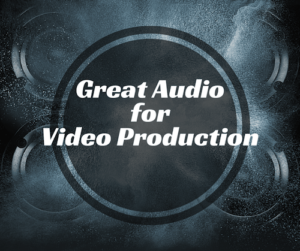
Always Use Your Camera Mic
Usually you don’t get good audio from the camera’s mic but this is a wonderful way to provide a safety net for when it is time to assess your footage and piece your clips together. You should always have separate sound (i.e. lavalier microphone system, blimp mic, fuzzy windscreen); if something goes wrong with one of your lavalier mics or there is excessive static from a short then you still have usable sound footage. Utilizing the mic on your camera will also provide for ambient sound that you did not think to capture as well as help as a reference during post production if by chance you did the unspeakable thing of not marking your shots or leaving your clapboard at home. Which leads me to this…
The Clapboard is Your Best Friend
When I first embarked on my journey into film, I failed to truly understand the importance of a clapboard. With my first short film, I was in such a rush to get through the shots and to wrap up production that I didn’t even notice that part of our crew had dwindled, including the person responsible for the clapboard. I thought this to be a minimal problem since I had written the film myself and had each shot memorized. Needless to say that was reckless thinking—thinking that led to hours upon tedious hours of listening to each individual audio clip as I attempted to match the talent’s dialogue with the footage. A simple gesture of clapping my hands in front of the lens and shouting out the scene and shot numbers could have saved me weeks of audio tedium, allowing me to spend more time on color correcting and grading. If you don’t have a clapboard, I suggest that you at least write your scenes on a piece of paper and put that paper in front of the camera before shouting action; this one tip will be worth the time you spent reading this blog one-thousand fold.
Avoid Camera Shake and Camera Chatter
This may seem odd since I’m discussing sound, but if you run into the unfortunate event where the only salvageable audio is from your camera mic, then it won’t help much if that audio is saturated with movement, scratching, coughing, breathing or sidebar conversations. Don’t move around while filming; the subject of your video could be reaching the pivotal moment of his or her speech and your background chatter could ruin the shot.
Say No to Echo
One of the audio annoyances almost impossible to remove in postproduction is echo. Always check the acoustics in the environment in which you’re filming. Try to preplan as much as possible to avoid picking up echo. Depending on the size of the space involved, you may be able to use a sound blanket or absorption sheet to avoid this monster. There are plug-ins such as Unveil for Adobe Premiere Pro (and of course Adobe Audition) that may reduce some of the damage that echo causes; however, it is so much better to prepare before filming so as to avoid the echo heard in a large banquet hall, auditorium, or gym.
In summary, video cannot exist without the partnership of audio. While marketing our clients, not only do they count on Blueprint to provide stimulating visuals through graphics and video but each client has a voice of their own. We are not only the eyes and ears for our clients but we are their voice. We can only provide that voice with exceptional audio.